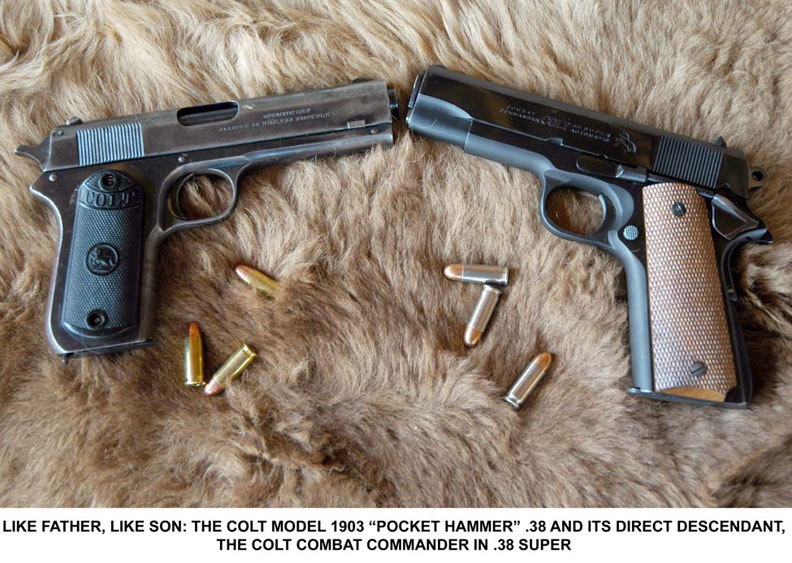
A TALE OF TWO .38’S: THE COLT 1903 “POCKET HAMMER” PISTOL AND THE .38 SUPER COLT COMMANDER
This essay originally appeared in Magnum, a sporting publication in South Africa

The late 19th and early 20th centuries were heady times for gun designers. Smokeless powder had
been invented in the mid-1880s, and while black powder was still widely used, clean-burning
smokeless powder had finally made autoloading 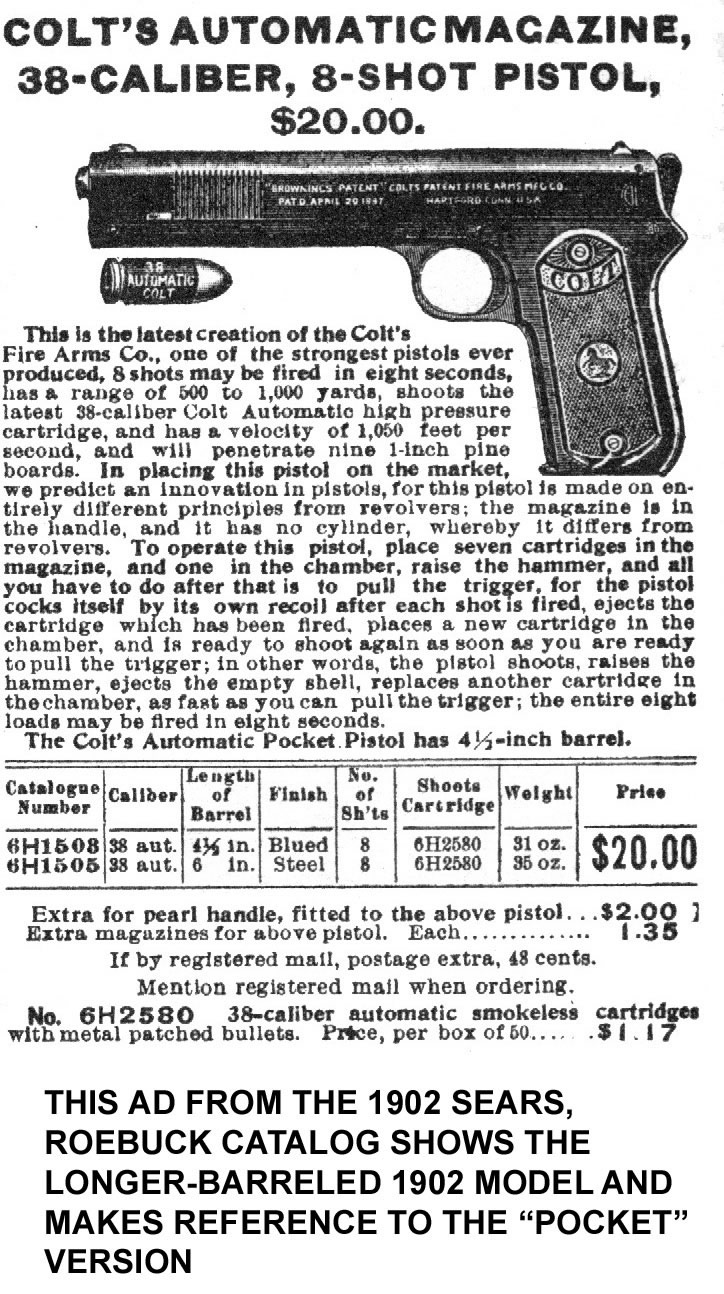 handguns a practical proposition. John M.
Browning’s fertile mind produced several innovative and iconic guns and calibers in this period,
including the Model 1900 .32, the Model 1908 Hammerless in .380, and the diminutive Model
1906 “Vest Pocket” in .25, all shooting cartridges that he developed for them.
handguns a practical proposition. John M.
Browning’s fertile mind produced several innovative and iconic guns and calibers in this period,
including the Model 1900 .32, the Model 1908 Hammerless in .380, and the diminutive Model
1906 “Vest Pocket” in .25, all shooting cartridges that he developed for them.
It was also a time of transition for the military: the United States, after a brief war with Spain, found itself embroiled in a much longer anti-insurrectionist campaign in the Philippine Islands. The Army’s double action revolvers in the anemic .38 Long Colt caliber weren’t a success in combat; and the brass hats were at the same time contemplating more modern weapons, especially autoloading handguns. Browning offered them his Model 1902 “Military” in his latest caliber, “.38 Automatic Rimless Smokeless.” It wasn’t adopted but the design laid the foundation for the long-lived and extremely successful Model of 1911 and its variants.
The .38 Rimless Smokeless, or as it’s known today, the “.38 ACP” (for “Automatic Colt Pistol”) was designed in 1900 for Browning’s first high-powered sporting pistol, which he patented in 1897. It was next chambered in the 1902 Sporting and Military Models, both full-sized holster weapons; but the market for a smaller version existed and within a year, Colt had brought out the “Model 1903 Pocket Hammer .38.”
The ballistics of the .38 ACP were comparable to other medium bore auto pistol calibers—most of which came on the scene a bit later— including the 9mm Parabellum (1902), and 9mm Largo (1910). On paper it was far superior to any .38 revolver round, firing a 130 grain full metal jacket bullet at a little over 1000 feet per second. In the late 1920’s the much stronger 1911 Government Model frame was chambered for “.38 Super Automatic,” with a power level significantly increased but the case dimensions left unchanged. In 1949, history repeated itself: the Government Model spawned the smaller and more concealable Commander, just as the 1902 Sporting had spun off the “Model 1903 Pocket Hammer.” A direct comparison between the M1903 and the Commander is very interesting, as it reveals something about the evolution of Browning’s approach to putting a powerful cartridge in a reasonably compact pistol.
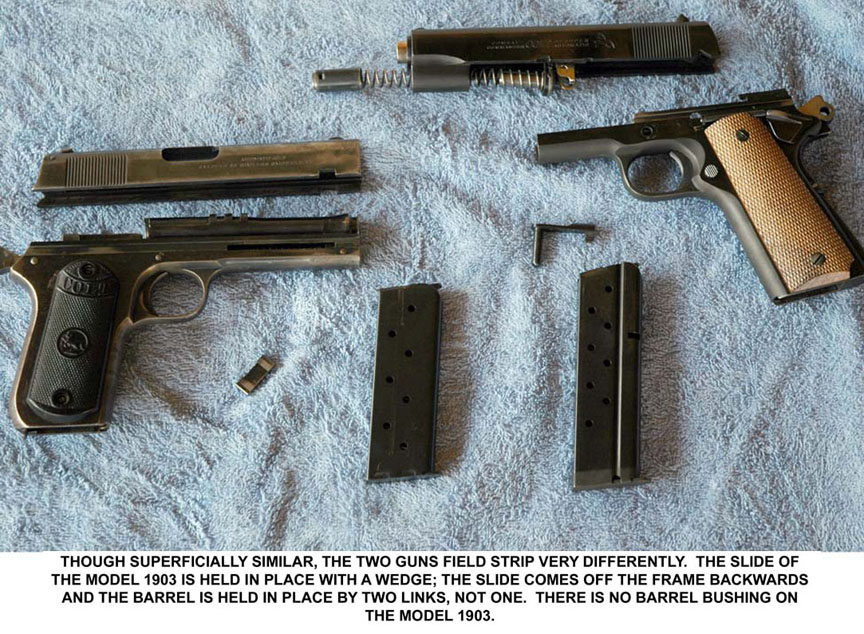
Both are locked-breech actions and both are slim, short, handy weapons that can be concealed fairly well. Closer examination, however, shows that the earlier gun had some design deficiencies that Browning worked hard and successfully to correct when he developed the Model 1911.
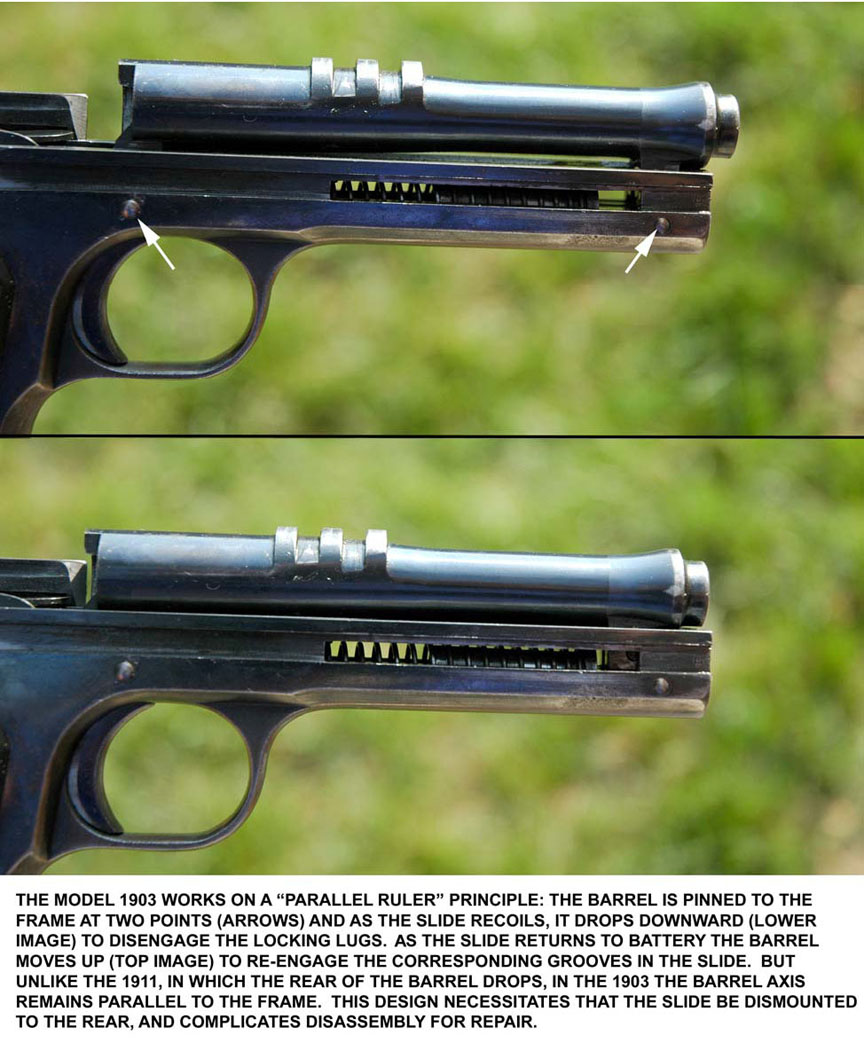
The principal difference is the means by which the slide is held in place. Everyone is familiar with the swinging link and dropping barrel mechanism of the M1911, but the M1903 doesn’t work that way, not quite. Instead, the barrel is pinned to the frame in two places; and as the slide moves to the rear under recoil, unlocking is accomplished by the dropping down of the entire barrel, not just its rear part.
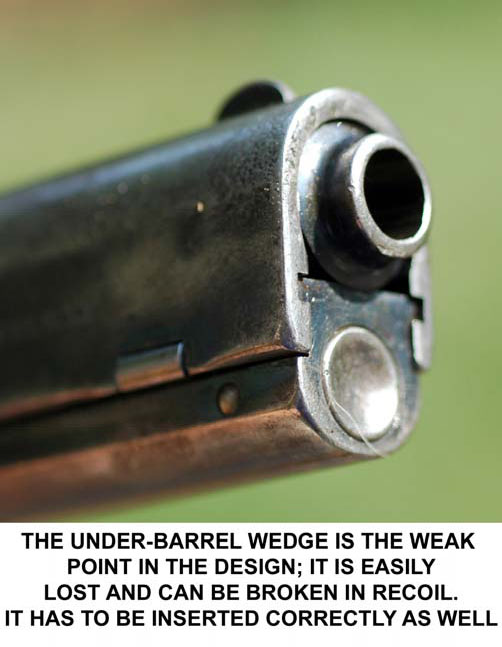 This is the “parallel ruler” principle. The axes of the barrel and the
frame remain parallel to each other throughout the entire firing and loading cycle.
Because the barrel is pinned to the frame, the slide can’t come off forwards, as in a M1911. It
must be removed by sliding it to the rear instead. To retain the slide a cross wedge is used,
passed through slots on either side of the frame and the slide, and resting on the recoil spring.
There’s no barrel bushing. The muzzle has a
slight “swell” that fills the front of the slide,
right over that wedge.
This is the “parallel ruler” principle. The axes of the barrel and the
frame remain parallel to each other throughout the entire firing and loading cycle.
Because the barrel is pinned to the frame, the slide can’t come off forwards, as in a M1911. It
must be removed by sliding it to the rear instead. To retain the slide a cross wedge is used,
passed through slots on either side of the frame and the slide, and resting on the recoil spring.
There’s no barrel bushing. The muzzle has a
slight “swell” that fills the front of the slide,
right over that wedge.
Now, the wedge works fine, if it’s there. The flaw here is that the wedge is small, has to be completely removed to get the slide off, and is easily lost. Putting it in requires that the shooter fiddle with it, and it’s easily dropped. This puts the gun out of commission because without that cross wedge…the slide will fly off when the gun is fired. And it will fly back and hit the shooter in the face, possibly causing serious injury. Browning corrected this in the M1911 by using the single swinging link that permits the slide to be drawn off forwards.
Other differences are less obvious. The Model
1903 has no safety catch at all, beyond the half cock
notch on the hammer, an “iffy” thing to
depend on. The M1903 can’t be safely carried
with the hammer at full cock, but leaving it at
half cock requires the shooter to thumb 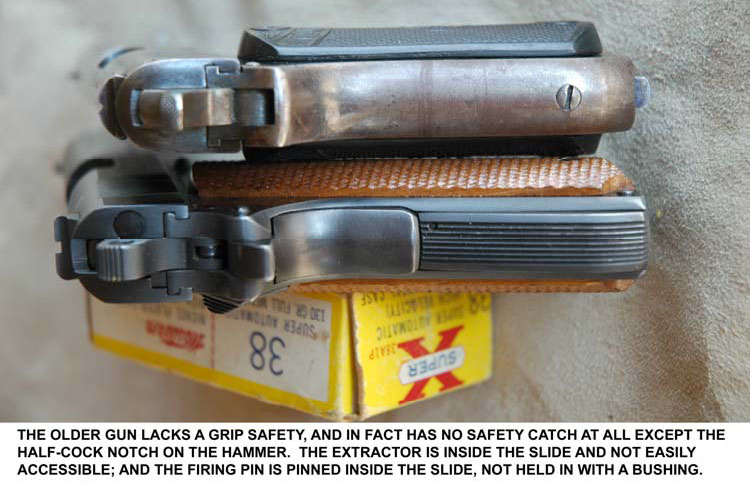 the
hammer all the way back for the first round. The Commander’s thumb safety comes off in an
instant with a completely natural motion.
the
hammer all the way back for the first round. The Commander’s thumb safety comes off in an
instant with a completely natural motion.
Nor does the Model 1903 have a grip safety that would prevent it from going off if dropped with the hammer at full cock. Browning certainly was familiar with grip safeties, as they had long been in use by 1900, so this omission is somewhat inexplicable.
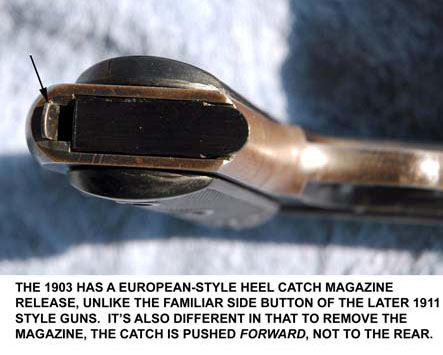 Early M1903’s had a “rowel” style hammer, like the
one used on the Commander today. Perhaps because
the gun couldn’t be carried “cocked and locked” and
so had to be cocked for the first shot, fairly early in
production Colt switched to a spurred hammer, as
seen on the example here. When the Commander
was brought out in 1949, Colt returned to the rowel
hammer, which is less likely to catch on clothing.
The Commander can of course be safely carried
“cocked and locked.”
Early M1903’s had a “rowel” style hammer, like the
one used on the Commander today. Perhaps because
the gun couldn’t be carried “cocked and locked” and
so had to be cocked for the first shot, fairly early in
production Colt switched to a spurred hammer, as
seen on the example here. When the Commander
was brought out in 1949, Colt returned to the rowel
hammer, which is less likely to catch on clothing.
The Commander can of course be safely carried
“cocked and locked.”
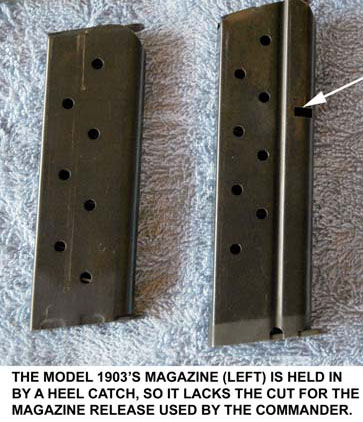
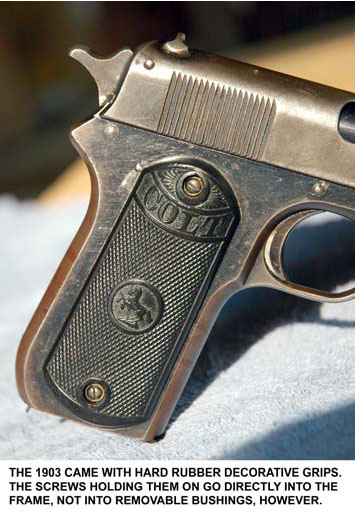 In designing the M1911, Browning had mounted
cavalry in mind, and their need for “one hand” operation of the pistol. The Commander’s
magazine release is a conveniently-located push button that drops the magazine free. Not so in
the Model 1903: it has a European-style heel catch mechanism requiring both hands to use. Yet
the heel catch is different from almost all others, in that to remove the magazine it’s pushed
forward, toward the muzzle, not backwards.
In designing the M1911, Browning had mounted
cavalry in mind, and their need for “one hand” operation of the pistol. The Commander’s
magazine release is a conveniently-located push button that drops the magazine free. Not so in
the Model 1903: it has a European-style heel catch mechanism requiring both hands to use. Yet
the heel catch is different from almost all others, in that to remove the magazine it’s pushed
forward, toward the muzzle, not backwards.
Other than these mechanical differences the two guns are more alike than they are different. Since both were intended as concealable weapons, they are compact and slim. Here the M1903 has the edge: its slide is 0.64” compared to the Commander’s 0.91”; and the decorative hard rubber grips measure less than 1.25” across the widest point.
The M1903’s barrel measures 4.5” including the chamber; the Commander’s is marginally shorter at 4.3”. The M1903 is slightly lighter, weighing exactly 2 pounds unloaded, the Commander (steel framed) at 2 pounds, 6 ounces. Both fit into any holster designed for the 1911-style frame perfectly. Fully loaded the M1903 holds 8 rounds, the Commander 10.

 The elegant molded grips of the M1903 are held in place by
screws that thread directly into the frame, not into removable
bushings. These screws are tiny and easily stripped. I found on
my pistol that one was long enough that when firmly seated, it
protruded into the magazine well and interfered with reloading.
The elegant molded grips of the M1903 are held in place by
screws that thread directly into the frame, not into removable
bushings. These screws are tiny and easily stripped. I found on
my pistol that one was long enough that when firmly seated, it
protruded into the magazine well and interfered with reloading.
Neither gun has much to boast of in the way of sights. The M1903 has sights typical of its time: a minuscule U-shaped rear notch dovetailed into the slide, complemented by an exceedingly skinny (0.055”) front blade. The Commander’s sights, while better, are nothing terrific. A Patridge type square notch rear with a robust (0.10”) flat-topped post. Of course, adjustable sights are nice to have but not really needed on a pistol for use at close range.
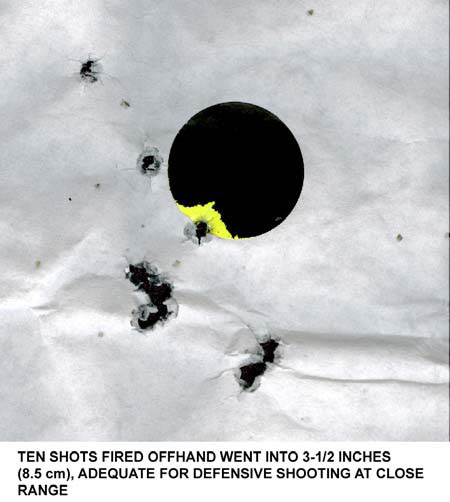 So how does the old gentleman shoot?
Pretty well. At 7 meters off a sandbag I
managed a 5-shot group of 1” (2.5 cm),
leaving aside a “flyer” that opened it up to
2” (5 cm): this with sights barely visible
to my aging eyes. Shooting offhand, I
found that while the M1903’s grip angle
appears awkward to modern eyes, it is in
fact very comfortable and the pistol points
instinctively, being beautifully balanced
and very trim in the hand. Offhand groups at the
same distance opened up to 3-1/2” (8.5 cm) for ten
rounds. Given the intended use of the M1903 for
defensive shooting, I found this level of accuracy
acceptable.
So how does the old gentleman shoot?
Pretty well. At 7 meters off a sandbag I
managed a 5-shot group of 1” (2.5 cm),
leaving aside a “flyer” that opened it up to
2” (5 cm): this with sights barely visible
to my aging eyes. Shooting offhand, I
found that while the M1903’s grip angle
appears awkward to modern eyes, it is in
fact very comfortable and the pistol points
instinctively, being beautifully balanced
and very trim in the hand. Offhand groups at the
same distance opened up to 3-1/2” (8.5 cm) for ten
rounds. Given the intended use of the M1903 for
defensive shooting, I found this level of accuracy
acceptable.
Recoil is modest using my handloads or factory .38 ACP. Cast bullets work just fine and are easy on the old barrel’s mild steel: Lyman’s #358211 round nose design (intended for the .38 Special) weighs 148 grains, and feeds perfectly, as the shape closely mimics that of the factory 130-grain FMJ’s. My handloads gave muzzle velocities with this bullet of 1000 FPS, with nominal muzzle energy of 319 Foot-Pounds, slightly better than the factory load (using 130-grain FMJ’s at 1030 FPS and 308 F-P) but not enough to matter.

By comparison, the .38 Super is rated at 1300 FPS, which with the 130-grain FMJ gives an energy reading of 490 FP. Therein lies some potential for danger: the .38 Super is dimensionally identical to the .38 ACP but far more powerful. The .38 Super round will fit and fire in the M1903, but using it is like feeding the gun a diet of proof loads.
Then, there is that weak locking wedge…while a M1903 in good condition is safe with the loads for which it was designed, it’s most decidedly not safe with the .38 Super or, Heaven forbid, the .38 Super +P ammunition that’s commonly available. Firing the +P stuff in this pistol will wreck it for sure and probably injure the shooter as well.
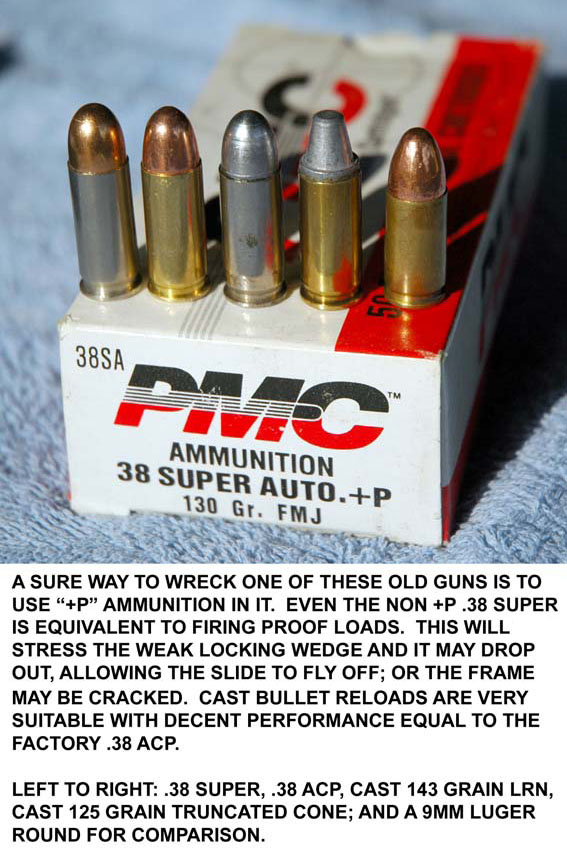
Ammunition companies no longer load .38 ACP, but the .38 Super is enormously popular with the IPSC crowd, and reasonably available. Unfortunately, most manufacturers of .38 Super seem not to have changed their die stamps and current-manufacture .38 Super is almost invariably headstamped “.38 ACP” ! (An exception is PMC, whose ammunition is correctly marked “.38 Super +P.”)
It’s OK to use empty .38 Super brass for reloading, but never, ever trust a “.38 ACP” headstamp on factory ammunition of unknown origin.
Another important point: you will sometimes read on the Internet that, “.38 ACP is loaded in brass cases, the .38 Super in nickeled ones, that’s how you can tell.” THIS IS NOT TRUE. I have several boxes of factory loaded .38 ACP in nickeled cases (Remington used these when loading this caliber) and some .38 Super in brass ones. PMC uses brass cases for their +P loads!
It’s best to use reloads of known performance and power level if you are lucky enough to get hold of one of these old pistols, or to buy loaded ammunition from a reputable custom cartridge supplier. True .38 ACP can be difficult to find, but I was able to get it from David Call at A Call To Arms, LLC in Buxton Maine, at a very reasonable price. It came with a label in large block letters that read “.38 ACP NOT .38 SUPER.”
My handload is a recipe from the 1964 Lyman Reloading Handbook: in 1964 both were being produced. I use a Lyman #358311 bullet over 5.0 grains of Alliant Unique powder. Size the bullet to 0.358” (nominal diameter for this caliber is 0.356”) and it won’t require crimping in resized cases. The .38 ACP, being semi-rimmed, doesn’t headspace on the case mouth.
According to various references, about 26,000 Model 1903 Pocket Hammer pistols were produced, and Colt cataloged it between 1903 and 1929. It wasn’t a big seller, perhaps because $20 was a lot of money in 1903, but perhaps also because people were much more familiar with revolvers and tended to distrust those new-fangled “automatics.” Indeed, in the “Roaring 20’s” autoloading pistols came to be associated in the minds of the public with gangsters, and revolvers with police!
Colt’s introduction of the Government Model in 1911 and the .38 Super version in 1929 spelled the end for the old “parallel rule” pistols. While they aren’t especially hard to find in good shooting condition, even today, M1903’s now have far more interest to collectors than ordinary shooters, which is probably just as well given the confusing ammunition situation. Though it will serve a knowledgeable user as intended, there are better alternatives for carry guns.
But the M1903 is reminiscent of a time when “Colt” was synonymous with “highest quality,” and even after 94 years, and considerable wear, my pistol is testimony to that. There are remnants of the beautiful high-polish blue Colt used in those days; it is still tight, accurate, and as functional as the day it emerged from the factory in 1917. As with anything else, condition is the prime consideration, and if you are looking for one of these, keep in mind that a really nice example commands a price well over $1200-1400, with pristine specimens going for two to three times that.
| HUNTING | GUNS | DOGS |
| FISHING & BOATING | TRIP REPORTS | MISCELLANEOUS ESSAYS |
| CONTRIBUTIONS FROM OTHER WRITERS|
| RECIPES |POLITICS |